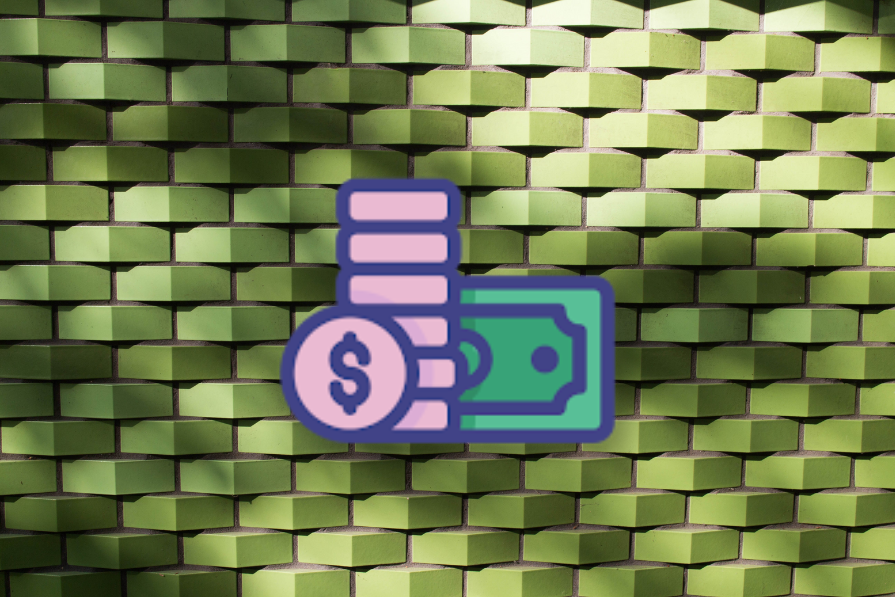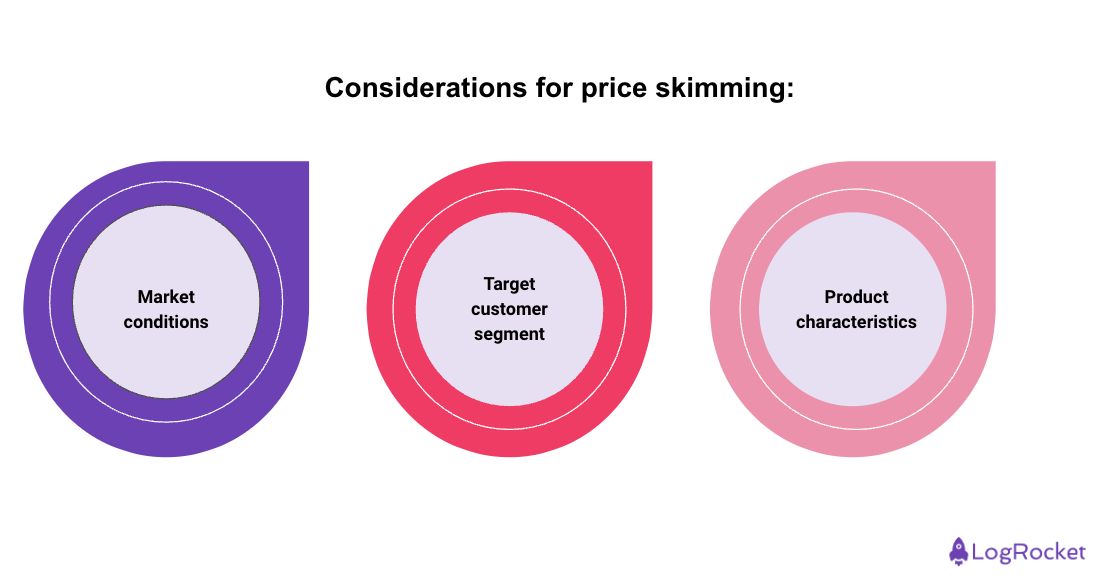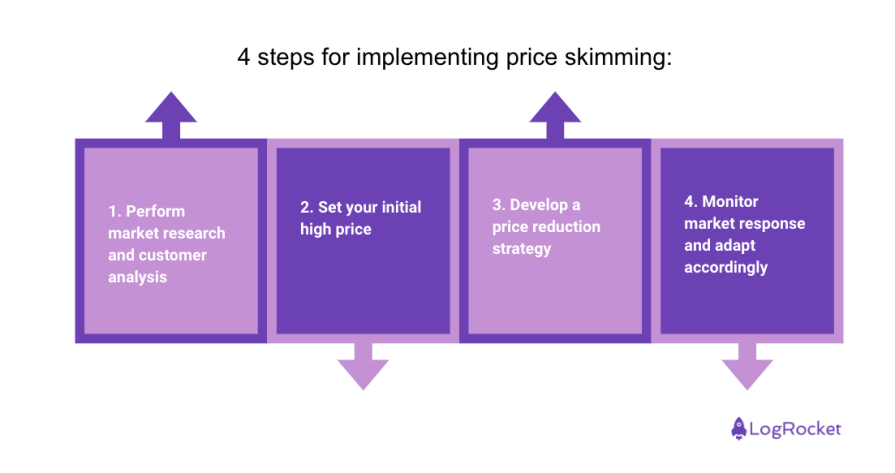When you go to launch a new product, setting the right price can feel like a high-stakes poker game with your customers. Before you get to the final decision, you should run customer discovery, evaluate what competitors look like, and develop a clear value proposition. All of these play into setting the price you put in front of customers.

Although seemingly negative, price skimming can be another important strategy in your product pricing toolbox. People often confuse price skimming for some kind of illegal pricing method when in fact it helps you maximize your product’s worth. This article explains how price skimming actually works by covering its advantages and drawbacks so you can make your own informed decision.
Price skimming is a strategic approach to pricing where you set a premium price at launch and gradually decrease it over time. This allows you to capture the value proposition early from those most willing to pay a higher price (think passionate early adopters). As competition enters the market, you can strategically lower the price to attract more price-sensitive customers, maximizing your overall revenue potential.
When it comes to product pricing, you should know the difference between three popular models: Price skimming, penetration pricing, and freemium pricing. The following chart outlines the three so that you can chose the one that makes the most sense for your particular product:
| Factors | Price skimming | Penetration pricing | Freemium pricing |
| Initial price | Starts high | Starts low | Has a free tier that provides the basic level of service offered at no cost |
| Price movement | Gradually decreases over time | May stay low or increase slightly | Upgrades to premium features come with a price, often a monthly or annual subscription fee |
| Target market | Targets early adopters with high willingness-to-pay | Targets the mass market with price sensitivity to attract a large customer base quickly | Targets a broad audience, usually users who may not be ready to commit to a paid service upfront but are interested in trying the product |
| Goals | Aims to capture maximum revenue early while consumer demand is high and competitors haven’t emerged Also, aims to establish a premium image | Focuses on gaining market share quickly and locking in new customers, or attracting customers from a prominent (but more expensive) competitor | Acquire a large user base and encourage user engagement with a goal to upsell/convert a portion of these free users into paying customers for premium features. It could also be to gather data on user behavior and preferences from free tier usage. |
| Examples | Nike, Luxury fashion brands | New streaming service with a free trial, budget-friendly electronics | Spotify, Canva, Grammarly |
Now that you have a sense of price skimming, these are some of the benefits you can expect:
Although price skimming can provide value, it comes with downsides as well:
Determining what pricing strategy to adopt requires careful consideration of the market conditions, your target customer segment, and your product’s value proposition. Price skimming can offer a superior pricing strategy depending on:

Limited competition or first mover advantage
Ideally, you want minimal competition initially, or your product should have a significant competitive advantage that justifies the higher price. This allows you to establish a strong market position and capture early profits before competitors arrive with potentially lower prices.
Early stage of the product life cycle
Price skimming is most effective during the introduction stage when there’s high initial demand and limited competition. As the product matures and competition increases, the price typically needs to be adjusted to stay competitive.
High initial demand and willingness to pay
There must be a segment of your target market with a strong desire for your product and a willingness to pay a premium for early access or exclusivity. This is often seen with:
Inelastic demand
Price skimming works best when the demand for your product is relatively inelastic. This means that a price increase won’t significantly decrease the number of customers willing to buy it. Hence, customers in your target market are not highly price sensitive. Luxury goods or products with a loyal customer base often exhibit inelastic demand.
High upfront development or production costs
Price skimming allows you to recoup high costs quickly before lowering the price for a broader market. This can be seen in industries like pharmaceuticals or high-end software with significant research and development expenses.
Innovation and competitive advantage
This could be highly innovative new products that offer groundbreaking features improvements or features not available elsewhere. Even established products with a clear advantage over competitors can benefit from price skimming. Customers are willing to pay more for the unique value proposition or to be among the first to experience it (e.g., new iPhone models).
Now let’s take a look at some real-world examples of price skimming so you can better understand its implementation.
Apple products
Apple is a classic example of price skimming. New iPhones and MacBooks are released at premium prices, targeting loyal customers and early adopters who value the latest technology and design.
As the product matures and competition increases, Apple gradually lowers the price, making it accessible to a broader audience. This allows it to capture both the high willingness-to-pay of early adopters and the larger market of price-sensitive customers later.
Gaming consoles
The latest generation of gaming consoles, like the Sony PlayStation 5 or Xbox Series X, often launch at a higher price point. This strategy targets enthusiastic gamers who want to experience the newest features and performance.
Later on, price drops and bundles with games become available, attracting a wider audience of casual gamers who might be more price-sensitive.
New software and services
New software or SaaS products may initially offer limited features at a higher price to capture early adopters willing to pay for the initial value and exclusivity. As the product matures, additional features are added and lower-tier pricing options are introduced, making it more attractive to a wider range of customers with varying needs and budgets.
To make implementing price skimming easy, you can follow these four steps:

If your product fits the ideal criteria for a price skimming approach and you intend to adopt the strategy, then here are some additional tips to set you up for success:
Price skimming can be a powerful tool for maximizing your product’s value, particularly during its initial launch. In ideal use cases, implementing the strategy carefully can position you to capture early profits, establish a premium brand image, and control market entry.
However, remember that price skimming isn’t a long-term solution. It’s important to focus on continuous innovation and strategic price reductions to ensure your product remains competitive and accessible to a broader audience as the market evolves. This sets your product up for long-term success and sustainable growth.
Featured image source: IconScout

LogRocket identifies friction points in the user experience so you can make informed decisions about product and design changes that must happen to hit your goals.
With LogRocket, you can understand the scope of the issues affecting your product and prioritize the changes that need to be made. LogRocket simplifies workflows by allowing Engineering, Product, UX, and Design teams to work from the same data as you, eliminating any confusion about what needs to be done.
Get your teams on the same page — try LogRocket today.

A practical five minute revenue estimation method to help product managers compare ideas, drop low impact features, and prioritize smarter.

A practical guide for PMs who want to stop being bottlenecks, delegate smarter, and lead teams effectively with a clear ownership framework.

Stop letting unreliable data block features. Treat data as inventory to track quality, ownership, and ship with confidence.

Learn why slide decks slow teams down and explore better tools like whiteboards, PRDs, and prototypes to improve collaboration and alignment.
2 Replies to "A guide to price skimming"
Great article! Loved the breakdown of price skimming and its practical applications. Curious to know how companies avoid alienating early adopters when prices drop. Thanks for the insights!
A well-explained guide on price skimming! It’s great to see how businesses can strategically use this pricing model to maximize early profits and stay competitive. Thanks for the valuable insights!